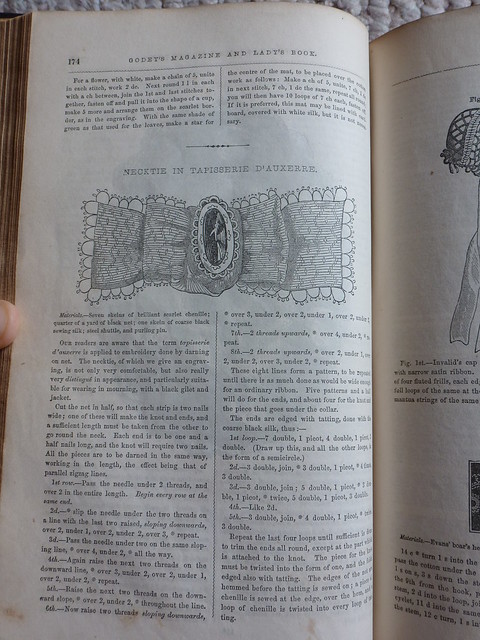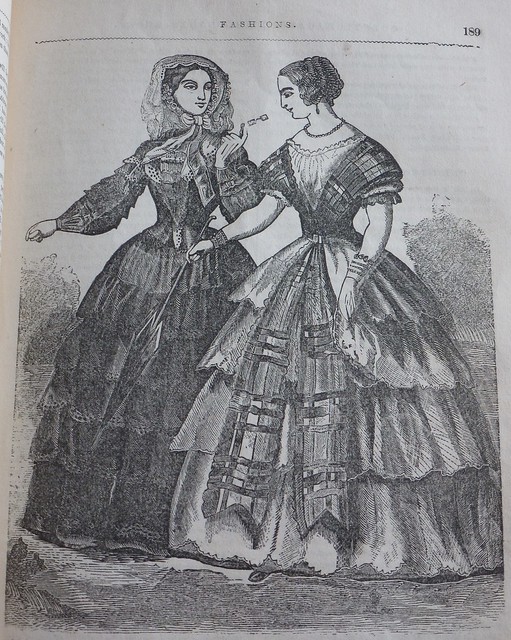I apologize in advance for the quality of the images. Although I have a scanner, I've discovered that there's no way I can preserve the integrity of the already fragile binding of the book and lay it flat. That means photos are the only options, and even those are difficult to achieve because of the tightly bound pages. I've done my best to ensure that everything is as clear and visible and undistorted as possible, but if there's something you really can't read or see and would like to have clarified, just let me know and I'll see what more I can do. I've set the images up so that if you click on them, they'll link you to their flickr page, where you'll be able to enlarge them all considerably and thus more easily read each one. Enjoy!
1853 Riding habit.
"Riding dress of an entirely new style, and intended for the coming spring season. The habit itself is of black pelisse cloth (a light broadcloth), the skirt being separate from the corsage, and plaited with broad plaits into a band, hooked or buttoned firmly about the waist. The basque is cut away very much in front, and displays a vest of buff fastened with small gilt buttons. The trimming upon the basque, and to the left of the skirt, is a rich ribbon or fold of green moir d'antique; the broad Vandyke collar of plain linen is fastened by a black silk necktie. Brown beaver hat, with a heavy plume, and gauntlet gloves, complete this elegant equestrian costume."
A necktie in tapisserie d'auxerre.
An invalid's cap and a nightcap;
pattern for eyelet-hole edging.
"Fig. 1st. - Walking dress of brown cashmere, the skirt composed of five flounces, edged with heavy embroidery of dots, to imitate raised velvet spots, in large scallops. The basque is trimmed to correspond, and the sleeves are in full flounces to match the skirt, a heavy, but novel style. Full cambric undersleeves, with two deep ruffles at the wrist, to carry out the complete effect of the dress, and a chemisette en suite. White satin and rich silk bonnet, with a wreath of blue convolvulus inside the brim; a heavy veil of blonde is the only external ornament.
"Fig. 2d. - Evening-dress of white Swiss muslin, intended for a young girl just entering society. The skirt is in four deep flounces, edged with an embroidery of scallops. The corsage is round, the fullness being disposed sheaf fashion from the waist to the shoulder, where it is edged by a narrow Velencienne lace. The sleeves are arranged to correspond, and the sole trimming consists of a broad ribbon of bright plaids, white and blue, green and rose color, or any other shade that may strike the fancy, placed en V on the back of the corsage, and from the shoulder to the waist, where it is confined by a girdle, and falls nearly to the hem of the dress in long flowing ends, like a scarf."
If you'd like to use or re-post or share these images, you're certainly welcome to do so. The only thing we ask is that credit is given where due: please provide a link back to this blog with the re-posted picture. Thanks!





3 comments:
Oh wow, what a great find! I think the images came out quite fine for a bit of historical research!
Laurie
That is a wonderful book to find! I love the dress on the right in that last fashion plate. Very pretty.
First time reading this, thanks for sharing
Post a Comment